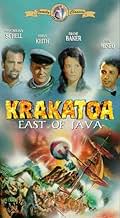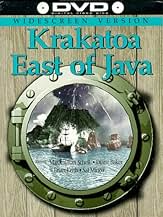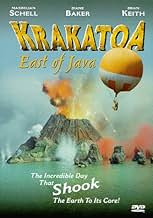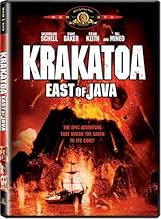CALIFICACIÓN DE IMDb
5.4/10
2 k
TU CALIFICACIÓN
Agrega una trama en tu idiomaIn 1883, ship captain Hanson plans a shipwreck salvage mission in The Dutch East Indies to retrieve a cargo of pearls but an unexpected volcano eruption and a state-ordered transport of conv... Leer todoIn 1883, ship captain Hanson plans a shipwreck salvage mission in The Dutch East Indies to retrieve a cargo of pearls but an unexpected volcano eruption and a state-ordered transport of convicts upset his plans.In 1883, ship captain Hanson plans a shipwreck salvage mission in The Dutch East Indies to retrieve a cargo of pearls but an unexpected volcano eruption and a state-ordered transport of convicts upset his plans.
- Dirección
- Guionistas
- Elenco
- Nominado a 1 premio Óscar
- 1 nominación en total
Jacqueline Chan
- Toshi
- (as Jacqui Chan)
Niall MacGinnis
- Harbor Master
- (as Niall Macginnis)
- Dirección
- Guionistas
- Todo el elenco y el equipo
- Producción, taquilla y más en IMDbPro
Opiniones destacadas
Resolutely old-fashioned, corny yet undeniably entertaining sea-faring adventure set in 1883. Maximilian Schell is cast as the most polite, soft-spoken ship's captain I've ever seen; he's on a mission to find a sunken ship off the coast of Singapore and raid it of its treasures. He brings several passengers aboard (a divorcée looking for her young son, father and son thrill-seekers, a deep-sea diver with bad lungs, etc.), as well as thirty shackled prisons whom he keeps down in the ship's galley. Great-looking movie originally released in the widescreen, three-camera Cinerama process, though the narrative is shaky from the beginning and the second-half is overloaded with repetitive volcanic explosions. The opening multi-screen montage of skin-divers and sunsets is beautifully presented--until you realize it's actually made up of scenes from the film which have yet to occur! The large cast is alternately wooden and unhappy, though the cinematography and special effects are good and DeVol's music score is rousing. Not a classic from the disaster movie genre, and saddled with a geographically incorrect title, but one that hopes to provide something for everyone. It's silly, but still quite a thrilling ride. *** from ****
I have been waiting since 1969 to see this, since it wasn't available on tape, and finally saw it on DVD on widescreen TV, home theater sound, etc, to get as close to the movie theater experience as possible. Too bad, because while the spectacle of all the adventure and effects are grand, the acting, dialog and direction borders on insipid. The director, Kowalski, was interesting with his two 50's sci-fi horror flicks, he was and has been basically a TV director and it shows here. He never really uses the big screen, not to mention Cinerama, to it's potential. He doesn't use the great (like Sal Mineo) and good (like Brian Keith) actors to their full potential. The effects are nice enough, but the same shots are used too often. Where there should be build up of suspense, there's only tedium and passing the time, much like typical 70s network TV fare. The writing is uninspired and much of the dialog is weak. There's plenty of dramatic plot elements to bring together and hit us in the gut, such as the woefully unexplored relationship of Mineo and Jacquie Chan, and this would have been great with a director the caliber of David Lean or Robert Wise. The first 15 minutes are very good and made me think it would be as good as, say, The Sand Pebbles, but alas, no. In the hands of an inspired talent, I dare say it could have had several academy award nominations, including Brian Keith for supporting actor, and it could have run nearly 3 hours and still have been engrossing. Well, MGM wasn't up to snuff in 1968-69, and so this is what we got. Normally, I'd give a 6 to a film like this, but it gets 4 because of all of the wasted potential. Could be a good remake though!
Though "Airport" and "The Poseidon Adventure" are most often credited with kicking off the 1970's disaster craze, this film clocked in just a tad earlier and certainly has its share of catastrophes (though nothing is more disastrous in it than the script!) Set in the late 1800's, Schell is the treasure-seeking captain of The Batavia Queen, a steamship bound for a sunken boat that promises to contain bags of huge, priceless pearls. Baker plays his love interest, a mentally troubled lady upon whose memory the entire mission rests. She is also seeking her lost son who her husband off-loaded somewhere before dying. Keith plays a Laudinum-addicted diver who is literally near his last breath. He's toting tacky would-be singer Werle (outfitted in a series of blonde wigs no doubt leftover from her many TV western appearances.) Also on board are father/son balloonists Brazzi and Mineo, bell diver Leyton and a quartet of Japanese female divers, famed for their breath-holding ability. Things get off to a rough start when a sailor falls to his death merely loading the diving bell onto the ship! Then a thoroughly inappropriate song (sounding like The Beach Boys) plays as the ship slips out of port. It gets worse from there as birds mass, fish die, the sky turns orange, smoke descends everywhere and chunks of lava rock are hurled at the boat (and this is before the climactic eruption of the title volcano which, as everyone knows by now, is WEST of Java, not east!) There's even a gaggle of prisoners placed on board to add to the troubles. In the meantime, a lot of dull, pointless dramatics play out amongst the "Grand Motel"-level cast. Baker frets, alternately wooden and over-the-top. Keith engages in drug-induced violence. Werle sings the planet's deadliest song while stripping off her horribly non-period, period costume. Mineo flirts with the oldest of the female divers. Schell wanders around with a nipple hanging out of his torn shirt. The bell and the balloon run into trouble. Nothing seems to go right for these hapless salvage-seekers and it only gets worse when Krakatoa decides to blow (and blow!) At this point, the volcano shoots like a Roman candle, filling the air with ash and creating a massive tidal wave that would make George Clooney and Mark Wahlberg jealous. If any of this sounds entertaining, it really isn't except for some of the special effects. The characters are never properly fleshed out and mostly don't share much discernible chemistry with each other. The screenplay couldn't be any more thoughtless and pointless, though there is one memorable line when lower class Werle barks at Brazzi, "Labels are for jelly jars!" That one would even do well in today's PC environment! The film was heavily edited after its initial release and what remains is so dull it's hard to imagine what was cut! The opening credits act as a sort of trailer for the film. Some audiences may want to let watching that suffice and skip the rest of the movie!
If only for its Oscar-nominated special effects simulating the fireworks caused by a very active Krakatoa, the film has enough eye appeal to be worth a look. But it's a pity that with a cast of talented actors aboard ship, the script and characters are so one-dimensional that after awhile one's mind wanders to watching for the next special effects sequence--and there are plenty of them to watch.
KRAKATOA, EAST OF JAVA almost looks as if it was designed for the 3D camera, with objects being tossed at the camera from above or below and must have looked even more spectacular on the big theater screen. The studio certainly has spared no expense in handsomely photographing this story of a salvage expedition that turns into a search for buried pearls on a shipwreck at the bottom of the sea. It includes a bevy of convicts aboard ship (a plot device that really makes no sense), while Captain MAXIMILIAN SCHELL stays at the helm of his ship steering it into one perilous situation after another and comforting his distraught passengers, including DIANE BAKER as a worried mother whose son is at a convent school near Krakatoa.
BRIAN KEITH, ROSSANO BRAZZI and SAL MINEO have cardboard supporting roles but go through their paces with conviction, never seeming to mind the one-dimensional aspect of their characters. Brazzi makes an ill-fated decision to leave the ship for shore when a tidal wave is about to approach and leaves his son (Mineo) aboard ship with the other characters who survive the storm.
There's virtually no plot to really hook the viewer into caring about the fate of these wooden characters. Even Schell seems much too calm to be amidst such dire situations involving the safety of his ship but manages to look ruggedly handsome in torn shirt as he watches the fireworks that seem to bombard the ship at various intervals throughout.
If the fireworks alone are enough to capture your interest, this is escapist adventure at best--but don't expect a plot that makes much sense. The characters all speak in modern phrases akin to 1969 rather than the late 19th century, an anachronism that gets lost in all the fiery explosions and fireworks of a raging volcano.
KRAKATOA, EAST OF JAVA almost looks as if it was designed for the 3D camera, with objects being tossed at the camera from above or below and must have looked even more spectacular on the big theater screen. The studio certainly has spared no expense in handsomely photographing this story of a salvage expedition that turns into a search for buried pearls on a shipwreck at the bottom of the sea. It includes a bevy of convicts aboard ship (a plot device that really makes no sense), while Captain MAXIMILIAN SCHELL stays at the helm of his ship steering it into one perilous situation after another and comforting his distraught passengers, including DIANE BAKER as a worried mother whose son is at a convent school near Krakatoa.
BRIAN KEITH, ROSSANO BRAZZI and SAL MINEO have cardboard supporting roles but go through their paces with conviction, never seeming to mind the one-dimensional aspect of their characters. Brazzi makes an ill-fated decision to leave the ship for shore when a tidal wave is about to approach and leaves his son (Mineo) aboard ship with the other characters who survive the storm.
There's virtually no plot to really hook the viewer into caring about the fate of these wooden characters. Even Schell seems much too calm to be amidst such dire situations involving the safety of his ship but manages to look ruggedly handsome in torn shirt as he watches the fireworks that seem to bombard the ship at various intervals throughout.
If the fireworks alone are enough to capture your interest, this is escapist adventure at best--but don't expect a plot that makes much sense. The characters all speak in modern phrases akin to 1969 rather than the late 19th century, an anachronism that gets lost in all the fiery explosions and fireworks of a raging volcano.
A guilty pleasure. Krakatoa, East Of Java's principal claim to fame is its title, infamously and erroneously placing its subject on the wrong side of the island. Directed by Bernard Kowalski, whose rare non-TV credits include Attack Of The Giant Leeches (1959), and SSsssnake (1973), the film is probably his best, aided immensely as it is by some excellent widescreen cinematography, emphasised with convincing location shooting -facts rarely allowed for in usual criticisms of a film which was cut by almost 30 minutes for an American re-release. The special effects, largely achieved through miniatures and blue screen work, range from passable to excellent and even now, in this era of eye watering CGI, there's still a fascination is seeing how well such a catastrophe was portrayed. The production design, by the veteran Eugène Lourié no less, is worth a discussion on its own.
In the face of this impending volcanic disaster is a nicely mixed group and one would expect plenty of steamy drama to be played out beneath sweltering decks. But the main problem the narrative is that, despite some promising elements, the audience has little empathy with the main group. Despite the long running time of the film (130 minutes in the full version), they remain too fragmented, and dramatic interest is often discharged too rapidly. But that's part of the fun, seeing how various matters are padded and dragged out between tantalising hints of the eruption to come. How some potential for real drama, like the love-hate relationship between father and son balloonists, or the latent sexuality of the Japanese women etc, is left to die by a unfocused script. For every wooden scene between between Hanson and Laura , one would dearly love more about the convict Dauzig's personal demons or his relationship with his comrades in chains below decks for instance, the resentful tension of which threatens to be every bit as violent as the island they are sailing towards.
But there's some incidental fun to be had along the way: one thinks of Keith and Werle in their cabin early on for instance, where she serenades him with a song as unexpected as it is irrelevant. It's a shipboard relationship between a heavyweight has-been and a shop worn female recalling that between Ernest Borgnine and Shelly Winters in The Poseidon Adventure of three years later. Keith's addict-diver with the 'shot lungs' provides other of the film's whacked out highlights too, as when, high on his drug, he hallucinates and attacks one of the Japanese women. Eventually confined to a crate suspended over deck until he regains his senses, Connerly is a man who seems doomed from the moment we see him. A point-of-view shot through the wooden bars during his moment of trial, lensed as he swings helplessly back and forth, suggests a prison in which a condemned man finds himself. Such is typical of a film that has many such moments, those in which characters peer at a world fraught with challenge. Whether through eyepieces, between slats, out of portholes, from balloons and diving bells, down into holds packed full of convicts or steaming volcanic cauldrons, apprehensive observation and anticipation is the norm for those who ride the Batavia Queen. These moments aptly reflect back the concerns of an audience who, in this film more than others, have come principally to observe a promised spectacular.
Such a visual motif is one of the few unifying elements in the film, other than the overarching expectation of an eruption. The overwhelming episodic nature of events is obvious, but at least it has the merit of making the film fairly diverse in content and, even in its full length version, time passes quickly enough in Krakatoa. On top of this, the concluding explosions and fireworks from the island aside, Kowalski does manage one or two effective scenes, such as the scenes in the runaway balloon, the near-comedy of which reminds one of the balloon antics in Those Magnificent Men In Their Flying Machines (1965), or the eerie sound effects caused by the nascent eruption (although one piece of eruption footage, conspicuously recycled, is a distraction). The simulation of audio effects one of the few times that the film actually reflects the subtle indications of such a massive event realistically as, for the rest of the film, the volcano is stereotyped into the usual 'burning mountaintop' image, set in mostly clear air at that, with the phenomenon of falling blankets of ash entirely overlooked. For some reason too, Krakatoa's eruption brings on a storm at sea - a nice easy, extra, touch of drama to be sure, although quite why volcanism should affect the weather is uncertain. Tossed and buffeted, Hanson's ship is a place of refuge amongst the impending devastation and, after dropping off one or two of the travellers who decide to sit out the expected tsunami on shore - a mistake in this situation, as any alert audience immediately realises - it faces the momentous tide alone. Like a similar wave that topples the aforementioned SS Poseidon, the one that comes up here seems to break mysteriously as it approaches the ship, but the outcome is never really in doubt. On shore, the results are worse, but reasonably well done, Kowalski's images suggesting something of a biblical deluge in scenes, which even the film's doubters still find impressive.
In fact so much has been leading up to the grand finale, so many supporting stories established, that one wishes that Krakatoa would go on a little longer than it does, at least so that there was time to gauge the effect of such tumultuous effects on the key participants. Ultimately, what impresses most these days is the absence throughout of the earnestness that attends so many modern disaster movies. The result is a still enjoyable film, one both flawed and innocent at the same time.
In the face of this impending volcanic disaster is a nicely mixed group and one would expect plenty of steamy drama to be played out beneath sweltering decks. But the main problem the narrative is that, despite some promising elements, the audience has little empathy with the main group. Despite the long running time of the film (130 minutes in the full version), they remain too fragmented, and dramatic interest is often discharged too rapidly. But that's part of the fun, seeing how various matters are padded and dragged out between tantalising hints of the eruption to come. How some potential for real drama, like the love-hate relationship between father and son balloonists, or the latent sexuality of the Japanese women etc, is left to die by a unfocused script. For every wooden scene between between Hanson and Laura , one would dearly love more about the convict Dauzig's personal demons or his relationship with his comrades in chains below decks for instance, the resentful tension of which threatens to be every bit as violent as the island they are sailing towards.
But there's some incidental fun to be had along the way: one thinks of Keith and Werle in their cabin early on for instance, where she serenades him with a song as unexpected as it is irrelevant. It's a shipboard relationship between a heavyweight has-been and a shop worn female recalling that between Ernest Borgnine and Shelly Winters in The Poseidon Adventure of three years later. Keith's addict-diver with the 'shot lungs' provides other of the film's whacked out highlights too, as when, high on his drug, he hallucinates and attacks one of the Japanese women. Eventually confined to a crate suspended over deck until he regains his senses, Connerly is a man who seems doomed from the moment we see him. A point-of-view shot through the wooden bars during his moment of trial, lensed as he swings helplessly back and forth, suggests a prison in which a condemned man finds himself. Such is typical of a film that has many such moments, those in which characters peer at a world fraught with challenge. Whether through eyepieces, between slats, out of portholes, from balloons and diving bells, down into holds packed full of convicts or steaming volcanic cauldrons, apprehensive observation and anticipation is the norm for those who ride the Batavia Queen. These moments aptly reflect back the concerns of an audience who, in this film more than others, have come principally to observe a promised spectacular.
Such a visual motif is one of the few unifying elements in the film, other than the overarching expectation of an eruption. The overwhelming episodic nature of events is obvious, but at least it has the merit of making the film fairly diverse in content and, even in its full length version, time passes quickly enough in Krakatoa. On top of this, the concluding explosions and fireworks from the island aside, Kowalski does manage one or two effective scenes, such as the scenes in the runaway balloon, the near-comedy of which reminds one of the balloon antics in Those Magnificent Men In Their Flying Machines (1965), or the eerie sound effects caused by the nascent eruption (although one piece of eruption footage, conspicuously recycled, is a distraction). The simulation of audio effects one of the few times that the film actually reflects the subtle indications of such a massive event realistically as, for the rest of the film, the volcano is stereotyped into the usual 'burning mountaintop' image, set in mostly clear air at that, with the phenomenon of falling blankets of ash entirely overlooked. For some reason too, Krakatoa's eruption brings on a storm at sea - a nice easy, extra, touch of drama to be sure, although quite why volcanism should affect the weather is uncertain. Tossed and buffeted, Hanson's ship is a place of refuge amongst the impending devastation and, after dropping off one or two of the travellers who decide to sit out the expected tsunami on shore - a mistake in this situation, as any alert audience immediately realises - it faces the momentous tide alone. Like a similar wave that topples the aforementioned SS Poseidon, the one that comes up here seems to break mysteriously as it approaches the ship, but the outcome is never really in doubt. On shore, the results are worse, but reasonably well done, Kowalski's images suggesting something of a biblical deluge in scenes, which even the film's doubters still find impressive.
In fact so much has been leading up to the grand finale, so many supporting stories established, that one wishes that Krakatoa would go on a little longer than it does, at least so that there was time to gauge the effect of such tumultuous effects on the key participants. Ultimately, what impresses most these days is the absence throughout of the earnestness that attends so many modern disaster movies. The result is a still enjoyable film, one both flawed and innocent at the same time.
¿Sabías que…?
- TriviaKrakatoa was actually located west of Java.
- ErroresKrakatoa is, in fact, west of Java.
- Créditos curiososThis film was shot using Super Panavision 70 and Todd-AO formats for presentation in single-strip Cinerama. The opening title sequence has the image devided into three frames just like the original three-strip Cinerama.
- Versiones alternativasOriginally premiered in Cinerama format at 136 minutes. After tepid reactions, film was cut to 101 minutes and re-released.
- ConexionesFeatured in Pinball Summer (1980)
Selecciones populares
Inicia sesión para calificar y agrega a la lista de videos para obtener recomendaciones personalizadas
- How long is Krakatoa: East of Java?Con tecnología de Alexa
Detalles
- Fecha de lanzamiento
- País de origen
- Idioma
- También se conoce como
- Krakatoa: East of Java
- Locaciones de filmación
- Cinecittà Studios, Cinecittà, Roma, Lacio, Italia(Studio, uncredited)
- Productoras
- Ver más créditos de la compañía en IMDbPro
Taquilla
- Total en EE. UU. y Canadá
- USD 2,403,403
- Tiempo de ejecución2 horas 11 minutos
- Relación de aspecto
- 2.20 : 1
Contribuir a esta página
Sugiere una edición o agrega el contenido que falta

Principales brechas de datos
By what name was Krakatoa, al este de Java (1968) officially released in India in English?
Responda
![Ver Trailer [OV]](https://m.media-amazon.com/images/M/MV5BYzk5MWFjZmUtOTVkYy00YmE0LWE5MzYtYjdlYWIxZjA4YWJiXkEyXkFqcGdeQXRyYW5zY29kZS13b3JrZmxvdw@@._V1_QL75_UY281_CR0)
































